|
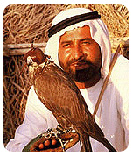 Culture
in Dubai is rooted in Islamic traditions that form UAE
National's lifestyles. It is highly important that when
tourists visit Dubai they must respect and behave suitably,
as the minority group of Emiratis are very protective
over their culture and traditions. Culture
in Dubai is rooted in Islamic traditions that form UAE
National's lifestyles. It is highly important that when
tourists visit Dubai they must respect and behave suitably,
as the minority group of Emiratis are very protective
over their culture and traditions.
Dubai is famously known as the entertainment capital
of the Middle East which attracts many party lovers
from all over the world, especially those who are wealthy
enough to splash out on the most expensive bars and
clubs in the city. With Dubai promoting such an image,
it still forbids the nationals that practice Islam to
indulge in any of the entertaining services offered.
In that respect these services are often located in
the more touristy areas rather than in residential parts.
Alcohol is not forbidden in Dubai, as long as it is
confined within an area like a hotel, bar or nightclub.
Residents are free to drink in their own homes as long
as they have an alcohol licence issued by the municipality.
It is illegal to drink in the street or in public places.
Pork is also available for the consumption of visitors
and expatriates.
It is advised that visitors and expatriates do not flaunt
their Western culture habits in the streets, where they
can be viewed by nationals who may find it offensive.
There have been various complaints in the past by nationals
who have expressed their views through the media about
their home-land being taken over by the Western world.
Having said this, it does not mean the locals are against
foreigners visiting Dubai, it is just common courtesy
to respect your hosts. Emiratis are traditionally known
for their warm hospitality and they are very generous
when offering refreshments to guests.
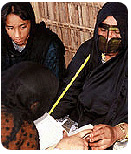 Emiratis
tend to dress in their traditional clothes influenced
by their Islamic belief. Most men prefer the traditional
dishdasha or khandura (a long white shirt-dress), with
ghutra (a white headdress) and agal (a rope worn to
keep the ghutra in place). The Emirati women tend to
wear an abaya (a long black cloak), which is worn over
conservative clothes, with a sheyla or hijab (a scarf
used to wrap around the face and head). Emiratis
tend to dress in their traditional clothes influenced
by their Islamic belief. Most men prefer the traditional
dishdasha or khandura (a long white shirt-dress), with
ghutra (a white headdress) and agal (a rope worn to
keep the ghutra in place). The Emirati women tend to
wear an abaya (a long black cloak), which is worn over
conservative clothes, with a sheyla or hijab (a scarf
used to wrap around the face and head).
Expatriates and visitors are advised to dress appropriately;
trousers or a dress should be worn to cover below the
knee, when circulating the city, especially at historical
sites. However, they can wear what they wish when they
are in a hotel, bar or club and swim wear is tolerated
by the pool or at the beach.
Normally tourist photography is acceptable and expected
with all the beauty Dubai has to offer. Photographs
of government buildings, military installations, ports
and airports should not be taken. Like anywhere, it
is polite to ask permission before photographing people,
especially an Emirati woman.
Religion
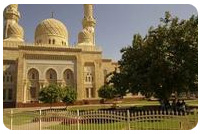 The most
religious time of the year in Dubai, is the fast of
Ramadan, which lasts approximately for one month. This
is when Muslims fast during day-light hours to fulfil
the fourth pillar of Islam. Tourists must be aware that
during this period, eating, drinking and smoking is
not permitted in public during the day, although some
restaurants blackout their windows to allow people to
consume in private. Also bars will not serve alcohol
before 7pm and clubs are shut as no loud music is allowed. The most
religious time of the year in Dubai, is the fast of
Ramadan, which lasts approximately for one month. This
is when Muslims fast during day-light hours to fulfil
the fourth pillar of Islam. Tourists must be aware that
during this period, eating, drinking and smoking is
not permitted in public during the day, although some
restaurants blackout their windows to allow people to
consume in private. Also bars will not serve alcohol
before 7pm and clubs are shut as no loud music is allowed.
The UAE is tolerant and welcoming to foreigners who
do not practice the religion of Islam. For example,
the huge Arab population in Dubai includes many from
Lebanon that can be of Christian faith and they are
freely allowed to follow their own religion as long
as they do not publicly distribute their literature.
This also applies to any other non-Muslim expatriates.
Once in the city of Dubai you are surrounded by many
mosques and the call of prayer will be heard frequently.
The city also accommodates other religious places of
worship, such as churches and Temples.
The government follows a policy of tolerance towards
non-Muslims and Polytheist and in practice, interferes
very little with their religious activities.
Dubai is the only emirate that has Hindu temples and
a Sikh gurudwara. The Meena Bazaar area of the city
has both a Shiva and Krishna temple. Both are believed
to be sanctioned by the late ruler of Dubai, Sheikh
Rashid Bin Saeed Al Maktoum. There is an electric crematorium
run by a group of Indian expatriates. Furthermore, in
early 2001, ground was broken for the construction of
several additional churches on a parcel of land in Jebel
Ali donated by the government of Dubai for four Protestant
congregations and a Catholic congregation. Construction
on the first Greek Orthodox Church in Dubai (to be called
St. Mary's) is due for completion in 2008/9, with the
help of General Sheikh Mohammad Bin Rashid Al Maktoum,
Dubai Crown Prince and UAE Defence Minister, who donated
a plot of land in Jebel Ali.
Language
The official language of the country is Arabic, however
most people in and out of the workplace communicate
in English. There are so many different nationalities
in Dubai and therefore English finds common ground with
most people. The majority of road, shop signs, and restaurant
menus etc. are in both English and Arabic.
Historical Time-Line leading
to the rise of Dubai
" 1830: The small fishing settlement of
Dubai is taken over by a segment of the Bani Yas tribe
from the Liwa Oasis, led by the Maktoum family who still,
interestingly, rule the emirate today.
" 1892: Foreign traders are drawn into
Dubai due to the declaration that they will be exempt
from tax, the population doubles and the pearling industry
is now booming.
" 1930-1940: The recession hits Dubai's
pearl industry which falls into decline leading to social
pressures and feuds between the royals.
" 1958: Sheikh Rashid officially becomes
the ruler of Dubai after his father's death.
" 1959: The Emir of Kuwait lends Sheik
Rahid millions of dollars to renovate the Creek so it
can accommodate large ships in order to develop Dubai's
reputation as being a major trading hub.
" 1966: Dubai discovers its own oil, attracting
traders to settle in Dubai which in turn enhances economic
growth.
" 1968: Dubai begins exporting crude oil
and petro-dollars rush in.
" 1973: The Dirham becomes the offical
unit of currency in Dubai.
" 1980: Dubai's annual oil income decreases
to US$3.
" 1985: The Emirates airline is established
and Dubai plans its reinvention as a tourist destination.
" 1990: Sheik Maktoum takes over as the
ruler of Dubai, due to his father, Sheik Rashid, passing
away during the first Gulf War.
" 1996: The Dubai shopping festival and
the Dubai World Cup are launched and happen to become
very popular annual events.
" 1999: One of the tallest hotels in the
world, the Burj Al Arab opens, enhancing Dubai's reputation
further as a tourist destination.
" 2003: Dubai is recognised by The International
Monetary Fund and the World Bank, as a financial hub.
Also, at this time the property market in Dubai suddenly
grows due to the introduction of freehold properties.
" 2006: Sheik Mohammed becomes the Prime
Minister and Vice President of the UAE, as well as the
ruler of Dubai. He updates the Liberal policies of his
Maktoum forefathers and develops Dubai further, raising
the city's business profile.
Geography
Geographical coordinates: 25° 15' 8" North,
55° 16' 48" East
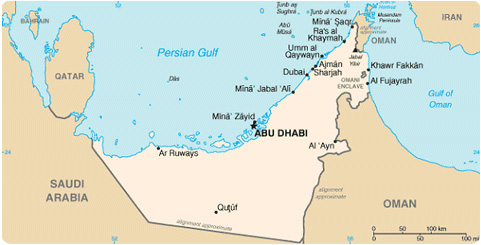 Dubai
is located on the Persian Gulf, in the northeast of
the United Arab Emirates. Dubai is the second largest
emirate with an urban area of 3885 sq km and the city
is roughly 35 sq km. However it will expand to twice
that size with the addition of the man-made islands;
the Waterfront, the three Palms, the World, the Universe,
Dubailand, as well as the construction in the desert. Dubai
is located on the Persian Gulf, in the northeast of
the United Arab Emirates. Dubai is the second largest
emirate with an urban area of 3885 sq km and the city
is roughly 35 sq km. However it will expand to twice
that size with the addition of the man-made islands;
the Waterfront, the three Palms, the World, the Universe,
Dubailand, as well as the construction in the desert.
One of the most fascinating geographical aspects of
Dubai, is its Creek, which divides the city into two
regions. Dubai Creek is made up of a natural 9.5 mile
inlet in the Persian Gulf, around which the city's trade
developed. North of the Creek is called Deira, and Bur
Dubai refers to the south where it joins the tourist
and residential developments of Jumeirah along the coast.
Dubai also has the highest population, sharing its borders
with Abu Dhabi in the south, Sharjah in the northeast
and the Sultanate of Oman in the southeast.
Due to the city's unique geographical location it enjoys
a strategic position which allows it to connect to all
local Gulf States, as well as to East Africa and South
Asia.
Climate
The line of the Tropic of Cancer crosses through the
UAE, causing the weather in Dubai to be warm and sunny.
In the winter it has an average daytime temperature
of 25°C , nearer the coast 12-15°C , in the desert or
mountains 5°C. With the nights being relatively cool.
Near coastal areas humidity can average between 50%
and 60%.
In the summer, the weather in Dubai is very hot and
humid, with temperatures reaching mid 40's. Even the
sea temperature can reach 37°C , with humidity averaging
over 90%.
Rainfall in Dubai is infrequent and does not last for
a long period. It mostly rains during the winter period
in the form of short gushes and an occasional thunderstorm.
On average, rain falls only five days a year.
Population
Dubai's population stands at an estimation of 1.5 million,
with three quarters of the population being male. The
city of Dubai is made up of a multicultural society;
with only 5% of local Emiratis, the rest are expatriates
from all over the world. The expatriate population comprises
of mostly Indians supplying the city with cheap labour
as well as filling professional positions, other nationalities
are from various Arabic countries. There is also a significant
amount of Iranians, especially after the Islamic revolution
in 1979 where more wealthy and educated Iranians settled
in Dubai. Furthermore, because of the high demand in
workers primarily in the tourism sector, many people
from the Philippines, China, Indonesia and Malaysia
have become residents in the city.
Dubai's population has been growing by around 7% a year
and the city is set to have a population of 2 million
by 2010.
Economy
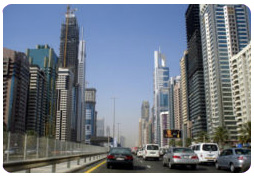 The economic
changes that have transformed Dubai into the city it
is today. The economic
changes that have transformed Dubai into the city it
is today.
Dubai is an important tourist destination and its port
(JebeL Ali) operates at the centre of the exporting
trade in the Middle East. With the introduction of the
Dubai International Financial Centre (DIFC) in 2004,
it has allowed Dubai to develop as a global hub for
service industries such as IT and finance.
The government has set up industry-specific free zones
throughout the city in order to attract foreign businesses
and this has been Dubai's greatest economic achievement.
The economy has benefited from new technological advances
of information and communication by the introduction
of The Dubai Internet City and Media City. Dubai has
tempted many established media companies, such as CNN,
to base their Middle East operations in the city.
Dubai is the second wealthiest emirate in the UAE, after
Abu Dhabi which is the capital state. Most tourists
believe Dubai's revenues came primarily from oil but
in fact it only used a moderate amount of oil reserves
to generate the infrastructure for trade, manufacturing
and tourism, in order to build up its economy.
About 95% of Dubai's Gross Domestic Product is not oil-based.
It is expected that by 2010, oil will account for less
than one percent of Dubai's GDP and tourism to produce
20% of the GDP. These figures explain why Dubai has
had to become a more dynamic and diversified economy
in order to survive the decay of fossil fuels.
In the early 1990's there were only a handful of hotels
available for tourists and Dubai never had high oil
revenues like Abu Dhabi so something had to change.
The Burj Al Project in 1994 (Burj Al Arab Hotel) gave
hope to the economy, as a long term strategy, an ambition
to become the world's top tourist destination.
Since then, Dubai has never looked back; it has rapidly
changed into an investor's playground with tourism rocketing
sky high. Dubai city hopes to accommodate 15 million
visitors in 2015.
Visa Requirements
IMPORTANT NOTIFICATION
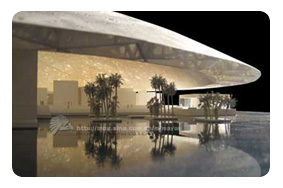 Citizens
of the Following Countries no longer need to obtain
a visa prior to entry if the duration of stay is less
than one (1) month: Citizens
of the Following Countries no longer need to obtain
a visa prior to entry if the duration of stay is less
than one (1) month:
United States, UK, France, Italy, Germany, the Netherlands,
Belgium, Luxembourg, Switzerland, Austria, Sweden, Norway,
Denmark, Portugal, Ireland, Greece, Finland, South Korea,
Spain, Monaco, Vatican, Iceland, Andorra, San Marino,
Liechtenstein,Canada, Australia, New Zealand, Japan,
Brunei, Singapore, Malaysia and Hong Kong.
GCC NATIONALS
Visa requirements for entering Dubai vary greatly between
different nationalities and it is always advised to
check regulations before traveling. Currently, every
nationality entering the UAE needs a visa except citizens
of GCC countries (Gulf Cooperation Council: Bahrain,
Kuwait, Oman, Qatar and Saudi Arabia) expatriate residents
of the GCC (certain nationalities and professions) and
British citizens with the right of abode in the UK.
The following citizens of Europe also receive visas
on arrival: Andorra, Austria, Belgium, Denmark, Finland,
France, Germany, Greece, Iceland, Ireland, Italy, Liechtenstein,
Luxembourg, Monaco, the Netherlands, Norway, Portugal,
San Marino, Spain, Sweden, Switzerland, and the Vatican.
In addition, nationals from Australia, Brunei, Hong
Kong, Japan, Malaysia, New Zealand, Singapore and South
Korea in Asia, as well as those from the United States
of America and Canada also now receive Visas on arrival.
GCC nationals can stay more or less as long they like.
British citizens can stay for a month and then apply
for a visa for a further two months. European, American,
South African and Australian citizens may obtain a visit
visa from the UAE embassy in their respective countries
before departure. Please note that Israelis and travelers
whose Passports bear Israeli stamps will be denied a
visa.
OTHER NATIONALS
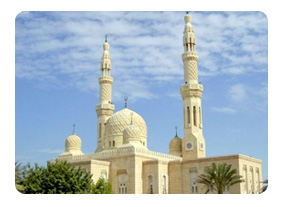 For all
other nationalities, a visa must be applied for before
the visitor enters the country either through their
respective embassy, a local UAE sponsor or a local hotel. For all
other nationalities, a visa must be applied for before
the visitor enters the country either through their
respective embassy, a local UAE sponsor or a local hotel.
VISAS THROUGH HOTELS
Tourists can get a visa from a tourist company or a
hotel by first making a reservation for at least one
night. They must fax/courier the hotel a copy of their
passport along with the reason for the visit (tourism
is an acceptable reason) and their arrival date. You
must also make sure that the hotel faxes you a copy
of the visa when it is ready. Airlines may require confirmation
(preferably a fax copy of the document) that a visa
is held before check-in at the airport. The original
is held at Dubai Airport for collection before passport
control.
SERVICE VISA ENTRY APPLIED THROUGH A HOTEL:
Standard process of application, but please check with
your hotel first.
The visa is valid for 14 days from the date of issue
and 14 days from the date of entry. The visa fees and
security deposit will vary from country to country.
The security deposit is also required per person and
will be refunded once the visa holder leaves the country.
It is advisable to contact your nearest Dubai Embassy
or the hotel for more details.
Please be aware that once the visa is applied for, charges
for the cost of the visa will not be refunded in such
cases as Expiration, Booking cancellation, Rejection.
For the visa to be processed by the hotel, the visitor
must remain a guest in that hotel for the entrire duration
of their stay. Port of entry and exit of the visitor
must be Dubai only. Three working days are needed to
process the visa excluding, Friday, Saturday and Public
Holidays.
Documents required:
Visa Charges and Security Deposit. An authorisation
letter with the signature of the cardholder, as well
as a copy of the credit card used (front and back side).
Passport copies of card holder and visitors.
Please note all document copies, passport copies and
credit card copies must be scanned clearly and with
colour when sent, otherwise they will be rejected by
Dubai Immigration.
TOURIST VISA
This visa is issued through tourist companies and it
is valid for 30 days. You cannot renew it or extend
it. If the Visa holder of the tourist visa stays more
than the 30 days, that person has to pay a fine per
day plus some charges for an out pass.
VISIT VISA
This Visa is issued through DNRD. It is stamped for
30 days validity but it is valid for 60 days and can
be extended for 30 more days by paying an extra amount.
The extension needs to be done before the 60th day.
If the visitor stays more than 60 days or more than
90 days (after the extension) they will have to pay
a fine per day plus some charges for an out pass.
Certain passport holders can enter the UAE without obtaining
a visit visa prior to arrival and stay up to 30 days.
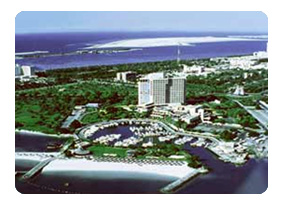 Documents
required: Documents
required:
1. Photocopy of the visitor's passport
2. Visit Visa Application form, completed and signed
by the sponsoring company.
3. Photocopy of the trade license of the company
4. A Guarantee letter from the company stating its responsibility
of the visitor during his visit.
WORK VISA
These visas are issued for people who want to work or
do business in UAE. It is valid for 60 days only, during
this the work residence visa has to be processed. If
the person delays in stamping the residence he will
pay 25 AED fine for each day.
There are different types of Work visas:
Private companies or Establishments employees (Issued
from labor Office)
1. Servants
2. Partners
3. Investors
4. Governmental institutions and Ministries (Issued
from DNRD) and the person can only work in governmental
institutions.
We suggest that you check with your nearest UAE consulate
or embassy whether you require a visa to be issued in
your passport prior to flying to the UAE.
For more information please visit http://uae-embassy.org/html/Consulate/General_Info.html
You could also find Links, address and phone numbers
of Embassies & Consulates in the UAE on Dubai.com
Blog.
Visit
Foreign Embassies-Consulates in UAE.
|
Dubai
What to see?
Burj AL Arab hotel, Jumeirah mosque, Juemirah beach, Madinat
Jumeirah suoq, Burj Dubai, Dubai museum, Gold&Spice
market, World Trade Center, Palm Islands and more.
What to do?
Desert Safari, Dhow cruise, Deep sea fishing, Helicopter
tour, Baloon tour, Spa and more.
What to eat?
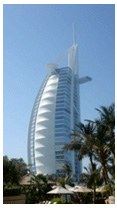 Burj
Al Arab restaurants (Al Mahara, Al Muntaha, Junsui, Al
Iwan, Bab Al Yam), Hyatt Regency Al Dawaar, Chinese restaurants,
Lebanese and Indian food. Burj
Al Arab restaurants (Al Mahara, Al Muntaha, Junsui, Al
Iwan, Bab Al Yam), Hyatt Regency Al Dawaar, Chinese restaurants,
Lebanese and Indian food.
Dubai is unusual in that its population is comprised mainly
of expatriates, with UAE nationals (Emiratis) constituting
the minority. The majority of these expatriates come from
South Asia and South East Asia. A quarter of the population
reportedly trace their origins to neighbouring Iran.[3]
Dubai is also home to some 100,000 British and other western
expatriates.
The official language is Arabic but English, German, Hindi/Urdu,
Malayalam, Tamil, Persian, and Tagalog are also widely
spoken. Islam is the majority religion of the Emiratis
and while a vast majority of the locals are Sunnis, there
is a significant Shiite minority. There are also minority
Hindus, Sikhs, and Christians. Dubai is the only emirate
that has Hindu temples and a Sikh Gurdwara.
SHARJAH
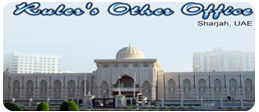 How to go? How to go?
By coach. from Dubai 25 km.
What to see?
King Faisal mosque, Quoraan square, Blue market(King
Khaled market), Animals & birds market.
What to eat?
Chinese, Lebanese, Arabian food.
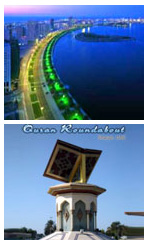 Sharjah
is a city of learning and the arts, as confirmed by
its 1998 UNESCO designation as the Cultural Capital
of the Arab World. This context facilitates the university's
intention to be an academic center at the intersection
of ancient cultural traditions and contemporary intellectual
currents. The city of Sharjah is home to more than 20
museums with splendid collections of artifacts and art
as well as exhibits on science and natural history.
Sharjah also host many cultural festivals, educational
conferences, fairs and economic expositions. These resources
permit the university to broaden students' formal education
in a way not possible elsewhere in the region. Sharjah
is a city of learning and the arts, as confirmed by
its 1998 UNESCO designation as the Cultural Capital
of the Arab World. This context facilitates the university's
intention to be an academic center at the intersection
of ancient cultural traditions and contemporary intellectual
currents. The city of Sharjah is home to more than 20
museums with splendid collections of artifacts and art
as well as exhibits on science and natural history.
Sharjah also host many cultural festivals, educational
conferences, fairs and economic expositions. These resources
permit the university to broaden students' formal education
in a way not possible elsewhere in the region.
Strategically situated between the Far East and the
West, Sharjah is a global trade center. The third largest
of the seven states that form the United Arab Emirates,
Sharjah (Al-Shariqa) probably has the most colorful
history of all the Emirates. From the days of the early
trading with the East to the settlement of the Qawassim
seafaring tribe and into the first half of the 19th
century, Sharjah was the most important port on the
lower Arabian Gulf.
Sharjah has beautiful beaches on the shores of the Arabian
Gulf in the West, and the Gulf of Oman and Indian Ocean
in the East. Sharjah is the only emirate to have land
on both the Arabian Sea and the Indian Ocean. Geographically,
Sharjah emirate covers approximately 2,600 square kilometers.
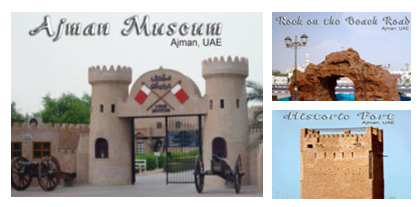 AJMAN AJMAN
How to go?
By coach from Dubai (35km)
What to see?
Ajman beach, Shikh palace, Ajman museum, Beach side
old fort.
The Emirate of Ajman is situated on the coast of the
Arabian Gulf, extending over a distance of 16 km, between
the emirates of Umm Al-Quwain and Sharjah. The area
of the emirate is 259 square kilometers, equivalent
to 0.3% of the country's total area, excluding the islands.
The population was estimated to be 80,000 in 1992.
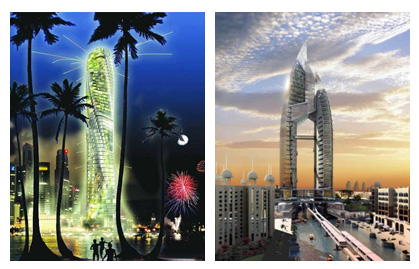 This
is the smallest Emirate of the United Arab Emirates
and lies between Sharjah and Umm Al Quwain. The central
area of Ajman is developed, while the rural area has
many farms. It has a few good fast food restaurants,
a City Centre (shopping mall) and cinema, and a traditional
Islamic designed souq. This
is the smallest Emirate of the United Arab Emirates
and lies between Sharjah and Umm Al Quwain. The central
area of Ajman is developed, while the rural area has
many farms. It has a few good fast food restaurants,
a City Centre (shopping mall) and cinema, and a traditional
Islamic designed souq.
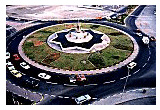 Al
Fujairah Al
Fujairah
How to go?
From Dubai by coach (199km)
What to see?
East coast, Friday market, mountains, Dibba, Masaafi
old museum, Shikh palace and beach.
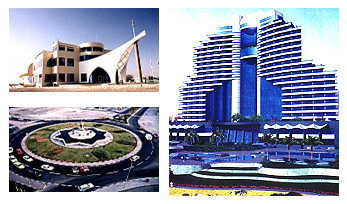 This
is an Emirate where people like to go sailing and bird
watching. It is famous for its Multi-million dirham
"Dreamland" Aqua park which attracts thousands
of visitors. Umm Al Qaiwain's popular archaeological
sites are Ad Door, a flourishing port town and nearby
Tell Abraq a fortified settlement from around 2,500
BC. It is also famous for Falaj Al Mu'ala a natural
oasis and an important agricultural area. This
is an Emirate where people like to go sailing and bird
watching. It is famous for its Multi-million dirham
"Dreamland" Aqua park which attracts thousands
of visitors. Umm Al Qaiwain's popular archaeological
sites are Ad Door, a flourishing port town and nearby
Tell Abraq a fortified settlement from around 2,500
BC. It is also famous for Falaj Al Mu'ala a natural
oasis and an important agricultural area.
UM AL-QUWAIN
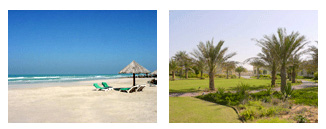 How to go? How to go?
From Dubai by coach (60km)
What to see?
Dream land water park and beach.
This Emirate has beautiful and very scenic mountain
scenery and the winding roads are part of its beauty
as you always wonder what scene is at the next turn.
It has waterfalls and beautiful untouched beaches which
are a major attraction to tourists and visitors from
abroad and within the UAE. The beaches are a great attraction
to divers who enjoy discovering the amazing marine paradise
of the UAE coasts.
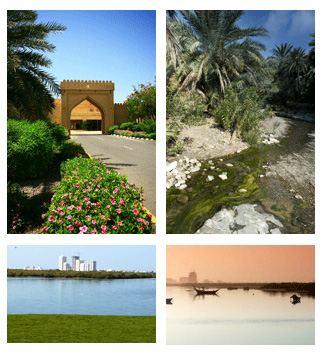 RAS
AL KHAIMA RAS
AL KHAIMA
How to go?
From Dubai by coach (102)
What to see?
Mountains, Shikh palace, Beaches and local villages.
This Emirate is one of the most natural beautiful spots
in the country. It is surrounded by sea, desert and
mountains. It is known for its camping grounds when
the weather is pleasant, natural water springs where
there are separate facilities for men and women to bathe
in its natural warm waters. The springs are located
next to the mountains In Sh'am. There are several very
interesting archaeological sites such as The Queen of
Sheba's Palace in the Shimal to the north.
|



